Influences of Heat Rejection from Split A/C Conditioners on Mixed-Mode Buildings: Energy Use and Indoor Air Pollution Exposure Analysis
Abstract
:1. Introduction
2. Methodology
2.1. Building Model
2.1.1. Environmental Conditions
2.1.2. Fabrics
2.1.3. Occupancy Pattern
2.1.4. Cooling Device
2.1.5. Mixed-Mode Cooling Strategies
- (all rooms 27 °C + low airflow rate): during occupied hours, all the rooms were cooled to a set-point of 27 °C. The outdoor units were set up to operate at a low airflow rate of 65 m3/min.
- (all rooms 27 °C + high airflow rate): during occupied hours, all the rooms were cooled to 27 °C. The outdoor units were set up to operate at a high airflow rate of 85 m3/min.
- (room five 23 °C and the rest 27 °C + low airflow rate): during occupied hours, the top-floor room (i.e., room 5) was cooled to 23 °C, whereas the rest were cooled to 27 °C. The outdoor units were set up to operate at a low airflow rate of 65 m3/min.
- (room one 23 °C and the rest 27 °C + low airflow rate): during occupied hours, room 1 (i.e., the room on the bottom floor) was cooled to 23 °C, whereas the rest were cooled to 27 °C. The outdoor units were set up to operate at a low airflow rate of 65 m3/min.
- (no window opening): all the windows in the building were closed. This reflects the ventilation pattern of a sealed air-conditioned building.
- (temperature-dependent window opening): a large indoor temperature swing can occur when the window was open, especially when there is a large indoor–outdoor temperature difference. This ventilation pattern aimed to comply with ASHRAE 55-2017 [31], which specifies that in order to reduce the negative impact of a large indoor temperature swing on occupant thermal comfort, the change in the temperature of the indoor air during a four-hour period should not exceed 3.3 °C. To meet the ASHRAE 55-2017 requirement, the temperatures inside and outside each room were calculated throughout the simulation period. When the difference in temperature between indoors and outdoors was in the range of 0 and , the window was open. When the indoor–outdoor delta temperature was larger than , the window was closed. In both cases, the window was closed if the air conditioning was on, if natural ventilation was not able to keep indoor temperatures below the cooling setpoint, or if no one was in the room. The value of was determined via a series of simulations, with varying from 5.8 °C (i.e., the difference between the lowest temperature of the ambient outdoor air and the cooling set-point) to 0 in increments of −0.1 °C. Simulations stopped when the ASHRAE 55-2017 requirement was met; the value of was then determined.
2.2. Simulations
2.2.1. EnergyPlus Simulations
2.2.2. Fluent Simulations
2.2.3. EnergyPlus and Fluent Co-Simulation
2.3. Validation
2.3.1. Airflow around Buildings
2.3.2. The Level of Air Pollution around Buildings
2.3.3. Space Cooling Demand and Indoor PM2.5
3. Results
3.1. Ambient Outdoor Temperatures
3.1.1. Windward Scenario
3.1.2. Leeward Scenario
3.2. Ambient Outdoor PM2.5 Concentrations
3.2.1. Windward Scenario
3.2.2. Leeward Scenario
3.3. Cooling Loads
3.3.1. Windward Scenario
3.3.2. Leeward Scenario
3.4. Indoor Levels of PM2.5 Exposure
3.4.1. Windward Scenario
3.4.2. Leeward Scenario
4. Discussion
4.1. Main Findings
4.2. Limitations and Future Research
5. Conclusions
- The mixed-mode building had higher cooling loads because of the increase in ambient outdoor temperatures due to heat rejection. This adverse energy effect was more significant when windows remained closed than when windows were open based on temperature difference;
- Placing outdoor units on the windward side is beneficial to disperse the rejected heat from outdoor units, whereas the leeward scenario may “trap” the heat. Therefore, the windward scenario had 60.6% lower cooling load increase than the leeward scenario;
- In the windward scenario, PM2.5 from the street was kept away from the buildings due to the airflow vortex generated by the heat rejection of the outdoor units, so the indoor PM2.5 was lower. Under the leeward scenario, the bottom-floor room saw higher ambient outdoor PM2.5 concentrations due to heat rejection; occupants in the bottom-floor room thus experienced greater exposure to indoor PM2.5;
- The combination of outcomes (2) and (3) indicates that outdoor units should be placed on the windward side of a building in order to reduce both the space-cooling demands and exposure to indoor PM2.5;
- An increase in the airflow rate of outdoor units offers the co-benefits of energy savings and occupant health under both the windward and leeward scenarios;
- Under the windward scenario, if one room needs to be cooled to a lower temperature than the others, the bottom-floor room is a better choice than the top-floor room for energy savings and occupant health.
Author Contributions
Funding
Data Availability Statement
Acknowledgments
Conflicts of Interest
References
- Hong, T.; Xu, Y.; Sun, K.; Zhang, W.; Luo, X.; Hooper, B. Urban microclimate and its impact on building performance: A case study of San Francisco. Urban Clim. 2021, 38, 100871. [Google Scholar] [CrossRef]
- Chow, T.T.; Lin, Z. Prediction of on-coil temperature of condensers installed at tall building re-entrant. Appl. Therm. Eng. 1999, 19, 117–132. [Google Scholar] [CrossRef]
- Chow, T.T.; Lin, Z.; Wang, Q.W. Effect of building re-entrant shape on performance of air-cooled condensing units. Energy Build. 2000, 32, 143–152. [Google Scholar] [CrossRef]
- Nada, S.A.; Said, M.A. Performance and energy consumptions of split type air conditioning units for different arrangements of outdoor units in confined building shafts. Appl. Therm. Eng. 2017, 123, 874–890. [Google Scholar] [CrossRef]
- Engelmann, P.; Kalz, D.; Salvalai, G. Cooling concepts for non-residential buildings: A comparison of cooling concepts in different climate zones. Energy Build. 2014, 82, 447–456. [Google Scholar] [CrossRef]
- Liu, S.; Kwok, Y.T.; Lau, K.K.-L.; Ouyang, W.; Ng, E. Effectiveness of passive design strategies in responding to future climate change for residential buildings in hot and humid Hong Kong. Energy Build. 2020, 228, 110469. [Google Scholar] [CrossRef]
- Bamdad, K.; Matour, S.; Izadyar, N.; Omrani, S. Impact of climate change on energy saving potentials of natural ventilation and ceiling fans in mixed-mode buildings. Build. Environ. 2022, 209, 108662. [Google Scholar] [CrossRef]
- Gens, A.; Hurley, J.F.; Tuomisto, J.T.; Friedrich, R. Health impacts due to personal exposure to fine particles caused by insulation of residential buildings in Europe. Atmos. Environ. 2014, 84, 213–221. [Google Scholar] [CrossRef]
- Jones, N.C.; Thornton, C.A.; Mark, D.; Harrison, R.M. Indoor/outdoor relationships of particulate matter in domestic homes with roadside, urban and rural locations. Atmos. Environ. 2000, 34, 2603–2612. [Google Scholar] [CrossRef]
- Canha, N.; Almeida, S.M.; Freitas, M.d.C.; Trancoso, M.; Sousa, A.; Mouro, F.; Wolterbeek, H.T. Particulate matter analysis in indoor environments of urban and rural primary schools using passive sampling methodology. Atmos. Environ. 2014, 83, 21–34. [Google Scholar] [CrossRef]
- Semmens, E.O.; Noonan, C.W.; Allen, R.W.; Weiler, E.C.; Ward, T.J. Indoor particulate matter in rural, wood stove heated homes. Environ. Res. 2015, 138, 93–100. [Google Scholar] [CrossRef] [PubMed]
- Taylor, J.; Davies, M.; Mavrogianni, A.; Shrubsole, C.; Hamilton, I.; Das, P.; Jones, B.; Oikonomou, E.; Biddulph, P. Mapping indoor overheating and air pollution risk modification across Great Britain: A modelling study. Build. Environ. 2016, 99, 1–12. [Google Scholar] [CrossRef]
- Taylor, J.; Shrubsole, C.; Symonds, P.; Mackenzie, I.; Davies, M. Application of an indoor air pollution metamodel to a spatially-distributed housing stock. Sci. Total Environ. 2019, 667, 390–399. [Google Scholar] [CrossRef] [PubMed]
- Taylor, J.; Shrubsole, C.; Davies, M.; Biddulph, P.; Das, P.; Hamilton, I.; Vardoulakis, S.; Mavrogianni, A.; Jones, B.; Oikonomou, E. The modifying effect of the building envelope on population exposure to PM2.5 from outdoor sources. Indoor Air 2014, 24, 639–651. [Google Scholar] [CrossRef] [PubMed]
- Keshavarzian, E.; Jin, R.; Dong, K.; Kwok, K.C.S. Effect of building cross-section shape on air pollutant dispersion around buildings. Build. Environ. 2021, 197, 107861. [Google Scholar] [CrossRef]
- Cui, D.; Li, X.; Liu, J.; Yuan, L.; Mak, C.M.; Fan, Y.; Kwok, K. Effects of building layouts and envelope features on wind flow and pollutant exposure in height-asymmetric street canyons. Build. Environ. 2021, 205, 108177. [Google Scholar] [CrossRef]
- Xiong, Y.; Chen, H. Effects of sunshields on vehicular pollutant dispersion and indoor air quality: Comparison between isothermal and nonisothermal conditions. Build. Environ. 2021, 197, 107854. [Google Scholar] [CrossRef]
- Hsieh, C.-M.; Aramaki, T.; Hanaki, K. Managing heat rejected from air conditioning systems to save energy and improve the microclimates of residential buildings. Comput. Environ. Urban Syst. 2011, 35, 358–367. [Google Scholar] [CrossRef]
- Adelia, A.S.; Yuan, C.; Liu, L.; Shan, R.Q. Effects of urban morphology on anthropogenic heat dispersion in tropical high-density residential areas. Energy Build. 2019, 186, 368–383. [Google Scholar] [CrossRef]
- Yuan, C.; Zhu, R.; Tong, S.; Mei, S.; Zhu, W. Impact of anthropogenic heat from air-conditioning on air temperature of naturally ventilated apartments at high-density tropical cities. Energy Build. 2022, 268, 112171. [Google Scholar] [CrossRef]
- Crawley, D.B.; Lawrie, L.K.; Winkelmann, F.C.; Buhl, W.F.; Huang, Y.J.; Pedersen, C.O.; Strand, R.K.; Liesen, R.J.; Fisher, D.E.; Witte, M.J.; et al. EnergyPlus: Creating a new-generation building energy simulation program. Energy Build. 2001, 33, 319–331. [Google Scholar] [CrossRef]
- Ansys, Inc. Ansys Fluids: Computational Fluid Dynamics (CFD) Simulation Software, version 2021; Ansys, Inc.: Canonsburg, PA, USA, 2021.
- EMPORIS. Building Types Hong Kong. 2017. Available online: https://www.emporis.com/city/101300/hong-kong-china (accessed on 16 September 2023).
- HKO. Climatological Information Services. 2021. Available online: https://www.hko.gov.hk/en/cis/climat.htm (accessed on 16 September 2023).
- EPD. Environmental Protection Interactive Centre: Air Quality Data—Download/Display. 2021. Available online: https://cd.epic.epd.gov.hk/EPICDI/air/station/?lang=en (accessed on 16 September 2023).
- Wan, K.S.Y.; Yik, F.H.W. Representative building design and internal load patterns for modelling energy use in residential buildings in Hong Kong. Appl. Energy 2004, 77, 69–85. [Google Scholar] [CrossRef]
- BD. Guidelines on Design and Construction Requirements for Energy Efficiency of Residential Buildings; Buildings Department Hong Kong: Hong Kong, China, 2014. [Google Scholar]
- ISO 13790; Energy Performance of Buildings, Calculation of Energy Use for Space Heating and Cooling. International Organization for Standardization (ISO): Geneva, Switzerland, 2008.
- CIBSE. CIBSE Guide A: Environmental Design; The Chartered Institution of Building Services Engineers: London, UK, 2006. [Google Scholar]
- Daikin. Engineering Data—Daikin AC; Daikin: Osaka, Japan, 2022. [Google Scholar]
- Standard 55-2017; Thermal environmental conditions for human occupancy. American Society of Heating, Refrigerating and Air Conditioning Engineers (ASHRAE): Peachtree Corners, GA, USA, 2017.
- Kikegawa, Y.; Genchi, Y.; Yoshikado, H.; Kondo, H. Development of a numerical simulation system toward comprehensive assessments of urban warming countermeasures including their impacts upon the urban buildings’ energy-demands. Appl. Energy 2003, 76, 449–466. [Google Scholar] [CrossRef]
- Taylor, J.; Shrubsole, C.; Biddulph, P.; Jones, B.; Das, P.; Davies, M. Simulation of pollution transport in buildings: The importance of taking into account dynamic thermal effects. Build. Serv. Eng. Res. Technol. 2014, 35, 682–690. [Google Scholar] [CrossRef]
- Meng, M.-R.; Cao, S.-J.; Kumar, P.; Tang, X.; Feng, Z. Spatial distribution characteristics of PM2.5 concentration around residential buildings in urban traffic-intensive areas: From the perspectives of health and safety. Saf. Sci. 2021, 141, 105318. [Google Scholar] [CrossRef]
- Taylor, J.; Mavrogianni, A.; Davies, M.; Das, P.; Shrubsole, C.; Biddulph, P.; Oikonomou, E. Understanding and mitigating overheating and indoor PM2.5 risks using coupled temperature and indoor air quality models. Build. Serv. Eng. Res. Technol. 2015, 36, 275–289. [Google Scholar] [CrossRef]
- Jones, B.; Das, P.; Chalabi, Z.; Davies, M.; Hamilton, I.; Lowe, R.; Milner, J.; Ridley, I.; Shrubsole, C.; Wilkinson, P. The Effect of Party Wall Permeability on Estimations of Infiltration from Air Leakage. Int. J. Vent. 2013, 12, 17–30. [Google Scholar] [CrossRef]
- Long, C.M.; Suh, H.H.; Catalano, P.J.; Koutrakis, P. Using Time- and Size-Resolved Particulate Data to Quantify Indoor Penetration and Deposition Behavior. Environ. Sci. Technol. 2001, 35, 2089–2099. [Google Scholar] [CrossRef]
- Liu, J.; Heidarinejad, M.; Pitchurov, G.; Zhang, L.; Srebric, J. An extensive comparison of modified zero-equation, standard k-ε, and LES models in predicting urban airflow. Sustain. Cities Soc. 2018, 40, 28–43. [Google Scholar] [CrossRef]
- Zhang, R.; Mirzaei, P.A.; Jones, B. Development of a dynamic external CFD and BES coupling framework for application of urban neighbourhoods energy modelling. Build. Environ. 2018, 146, 37–49. [Google Scholar] [CrossRef]
- Zheng, J.; Tao, Q.; Chen, Y. Airborne infection risk of inter-unit dispersion through semi-shaded openings: A case study of a multi-storey building with external louvers. Build. Environ. 2022, 225, 109586. [Google Scholar] [CrossRef] [PubMed]
- Franke, J.; Baklanov, A. Best Practice Guideline for the CFD Simulation of Flows in the Urban Environment: COST Action 732 Quality Assurance and Improvement of Microscale Meteorological Models; COST European Cooperation in Science and Technology: Hamburg, Germany, 2007. [Google Scholar]
- Tominaga, Y.; Mochida, A.; Yoshie, R.; Kataoka, H.; Nozu, T.; Yoshikawa, M.; Shirasawa, T. AIJ guidelines for practical applications of CFD to pedestrian wind environment around buildings. J. Wind Eng. Ind. Aerodyn. 2008, 96, 1749–1761. [Google Scholar] [CrossRef]
- Snyder, W. Guideline for Fluid Modeling of Atmospheric Diffusion; U.S. Environmental Protection Agency: Washington, DC, USA, 1981.
- Shirzadi, M.; Tominaga, Y. CFD evaluation of mean and turbulent wind characteristics around a high-rise building affected by its surroundings. Build. Environ. 2022, 225, 109637. [Google Scholar] [CrossRef]
- Gdeisat, M.; Lilley, F. 1—MATLAB® Integrated Development Environment. In Matlab by Example; Gdeisat, M., Lilley, F., Eds.; Elsevier: Amsterdam, The Netherlands, 2013; pp. 1–20. [Google Scholar] [CrossRef]
- Roache, P.J. Perspective: A Method for Uniform Reporting of Grid Refinement Studies. J. Fluids Eng. 1994, 116, 405–413. [Google Scholar] [CrossRef]
- Tominaga, Y.; Stathopoulos, T. CFD simulations of near-field pollutant dispersion with different plume buoyancies. Build. Environ. 2018, 131, 128–139. [Google Scholar] [CrossRef]
- Hanna, S.; Chang, J. Acceptance criteria for urban dispersion model evaluation. Meteorol. Atmos. Phys. 2012, 116, 133–146. [Google Scholar] [CrossRef]
- Leitl, B.; Schatzmann, M.C. Compilation of Experimental Data for Validation of Microscale Dispersion Models; Meteorological Institute of the University of Hamburg: Hamburg, Germany, 2010. [Google Scholar]
- Guideline 14–2014; Measurement of Energy, Demand, and Water Savings. American Society of Heating, Refrigerating, and Air Conditioning Engineers (ASHRAE): Peachtree Corners, GA, USA, 2014.
- Zhong, X.; Zhang, Z.; Wu, W.; Ridley, I. Comprehensive evaluation of energy and indoor-PM2.5-exposure performance of residential window and roller blind control strategies. Energy Build. 2020, 223, 110206. [Google Scholar] [CrossRef]

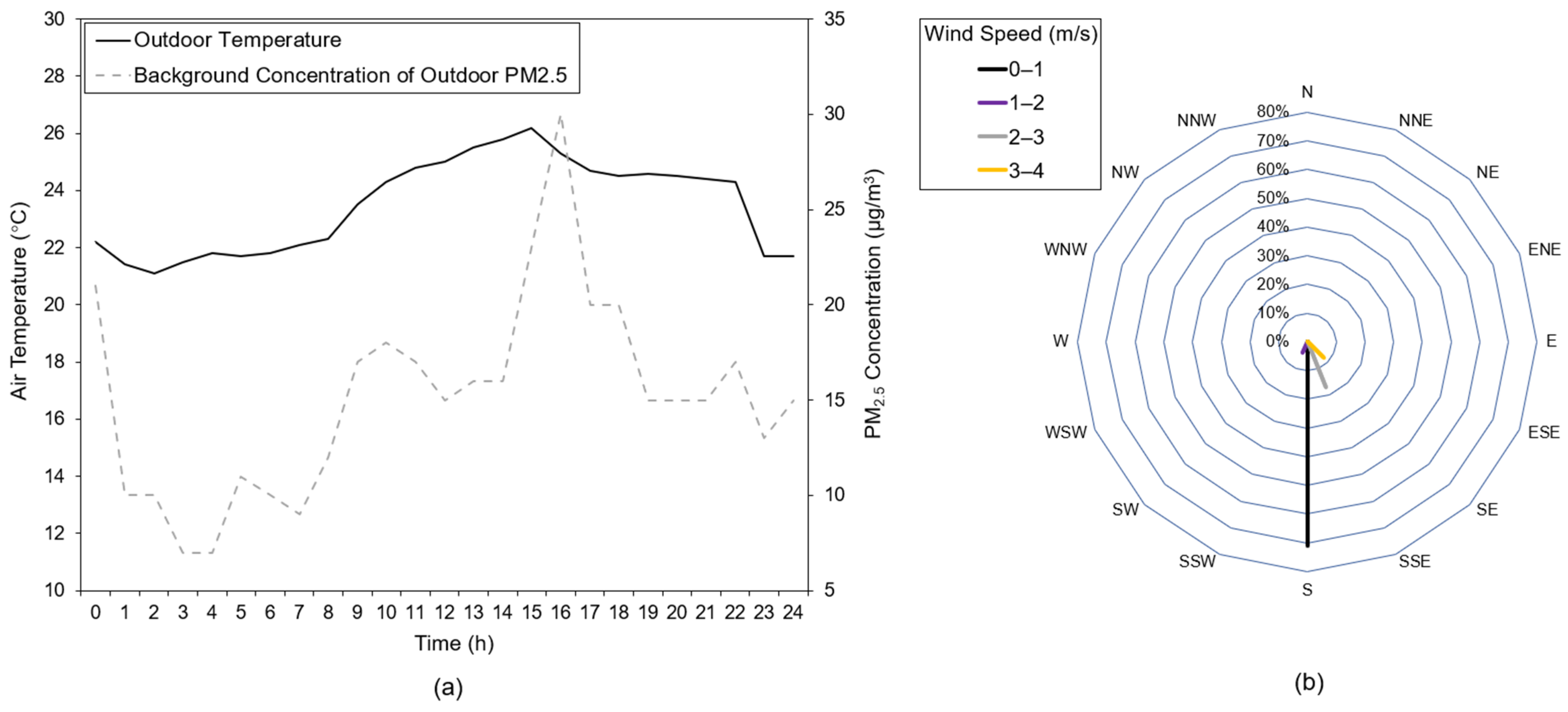
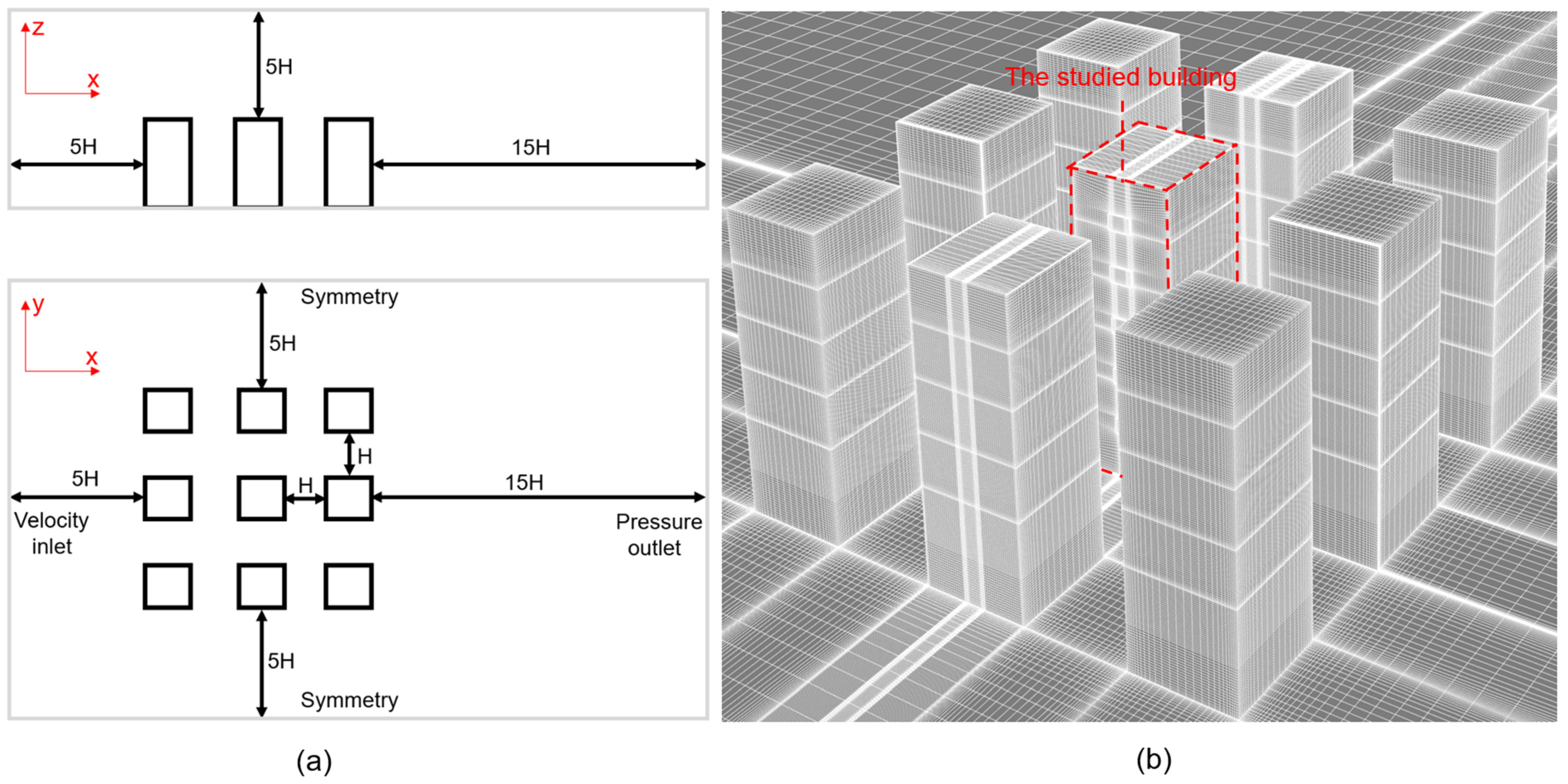


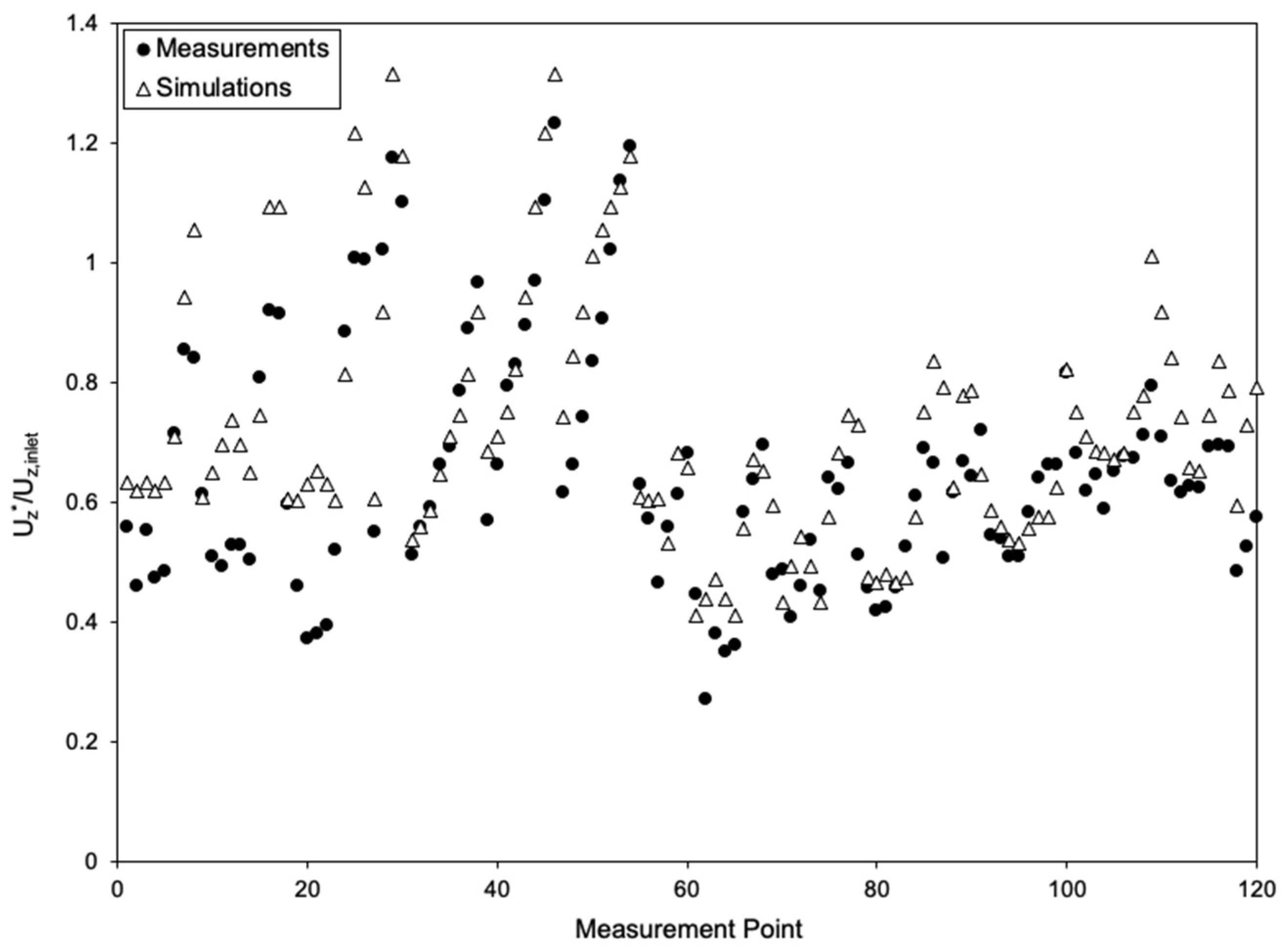
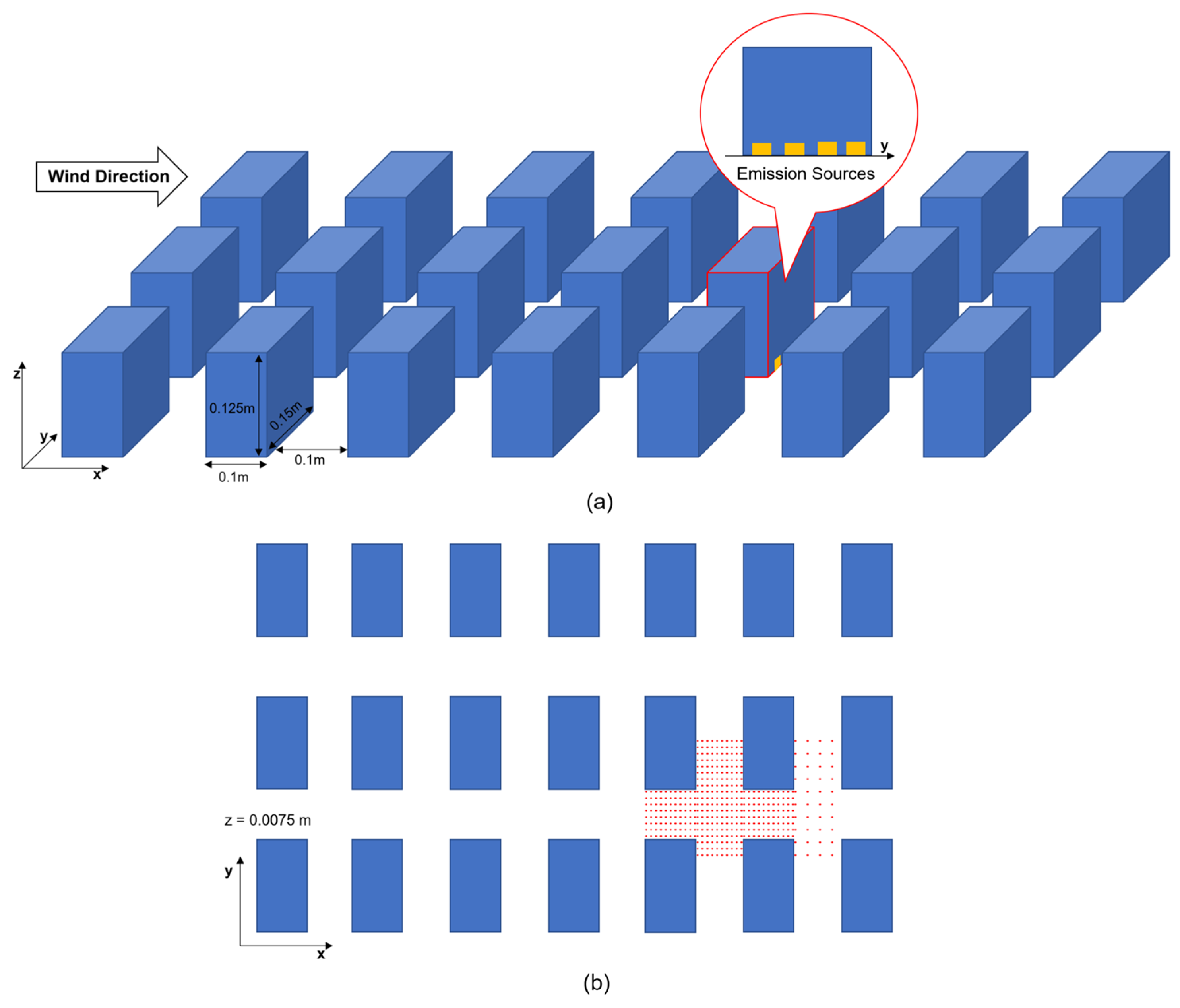

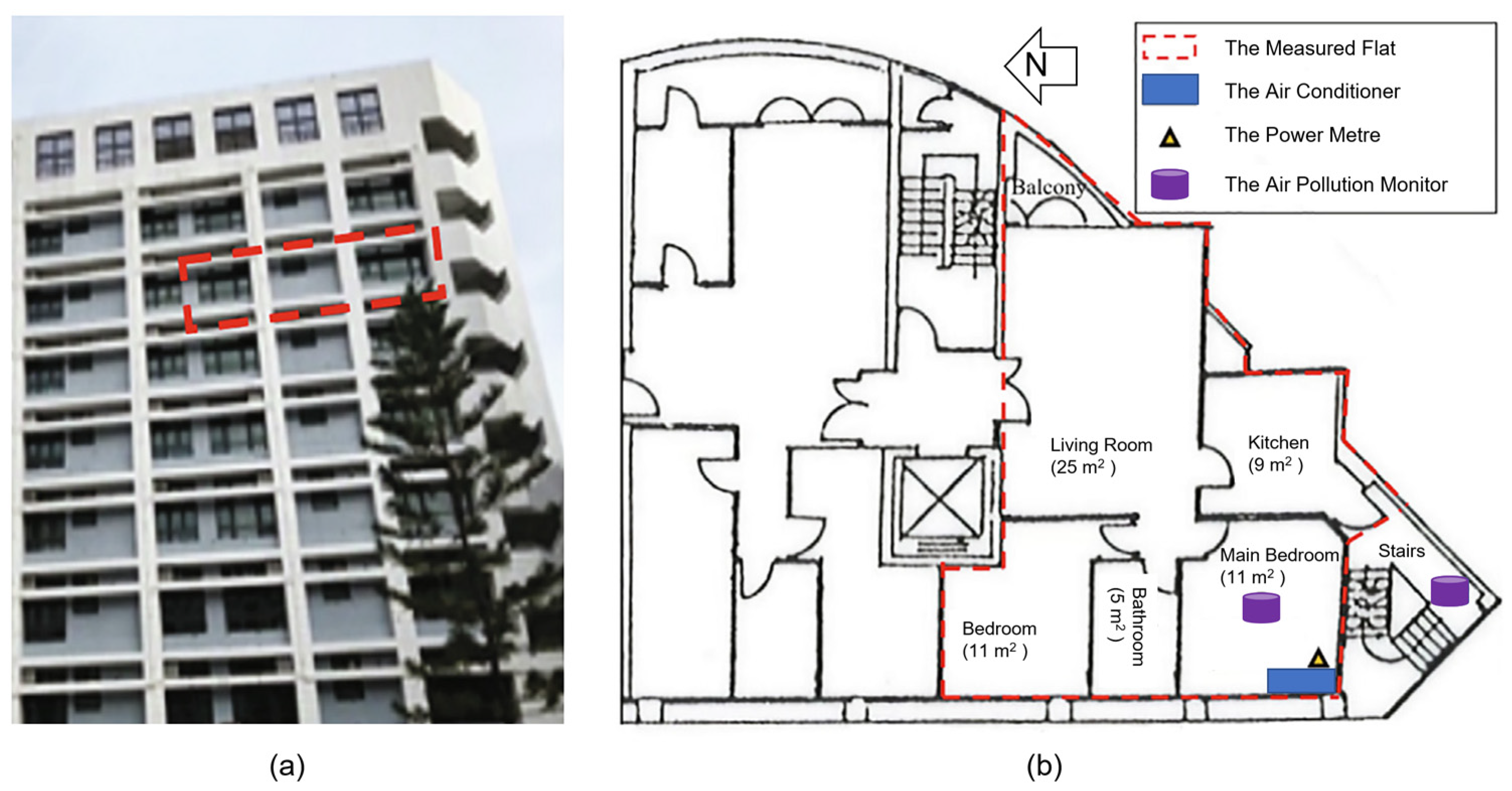
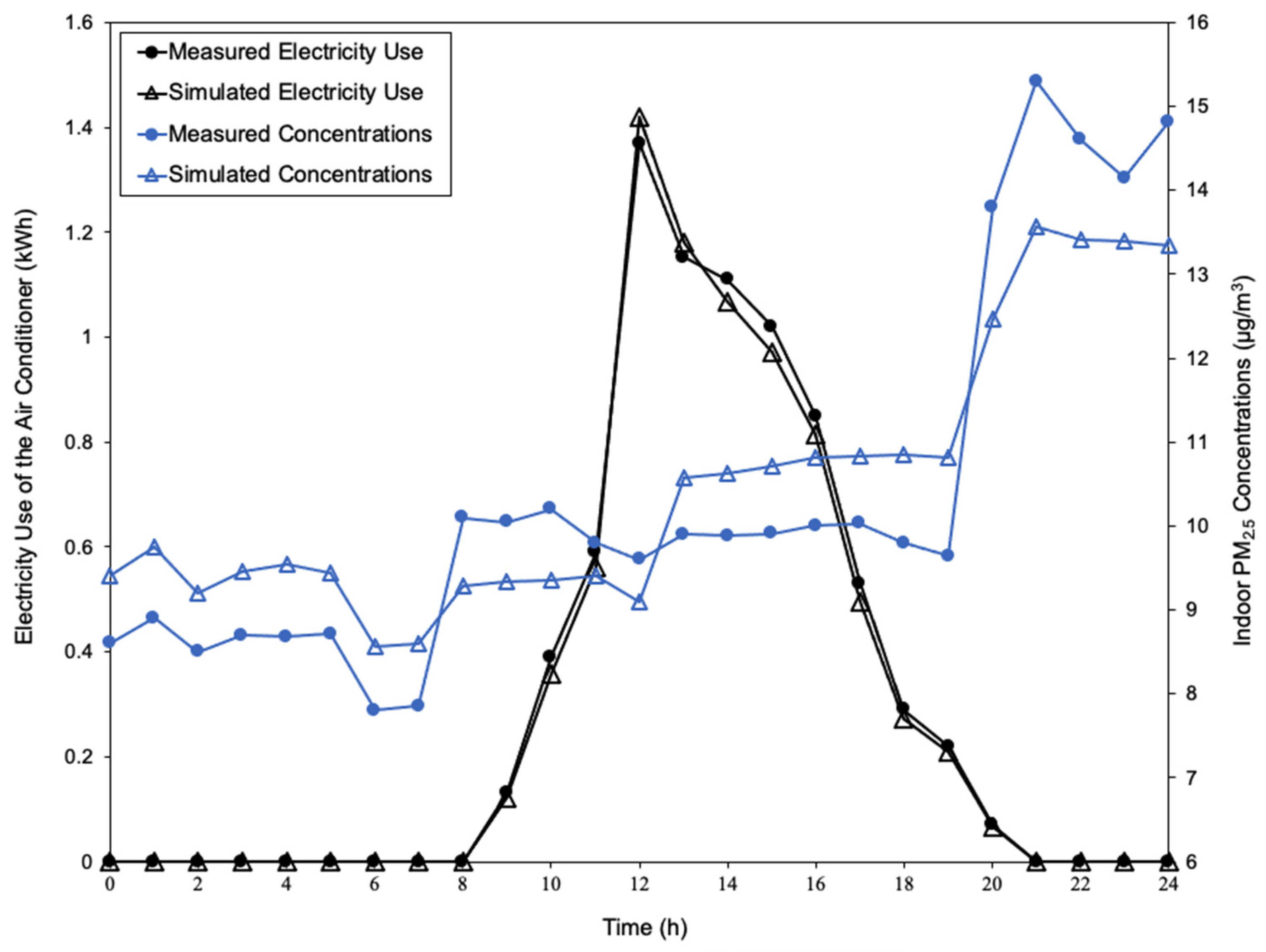
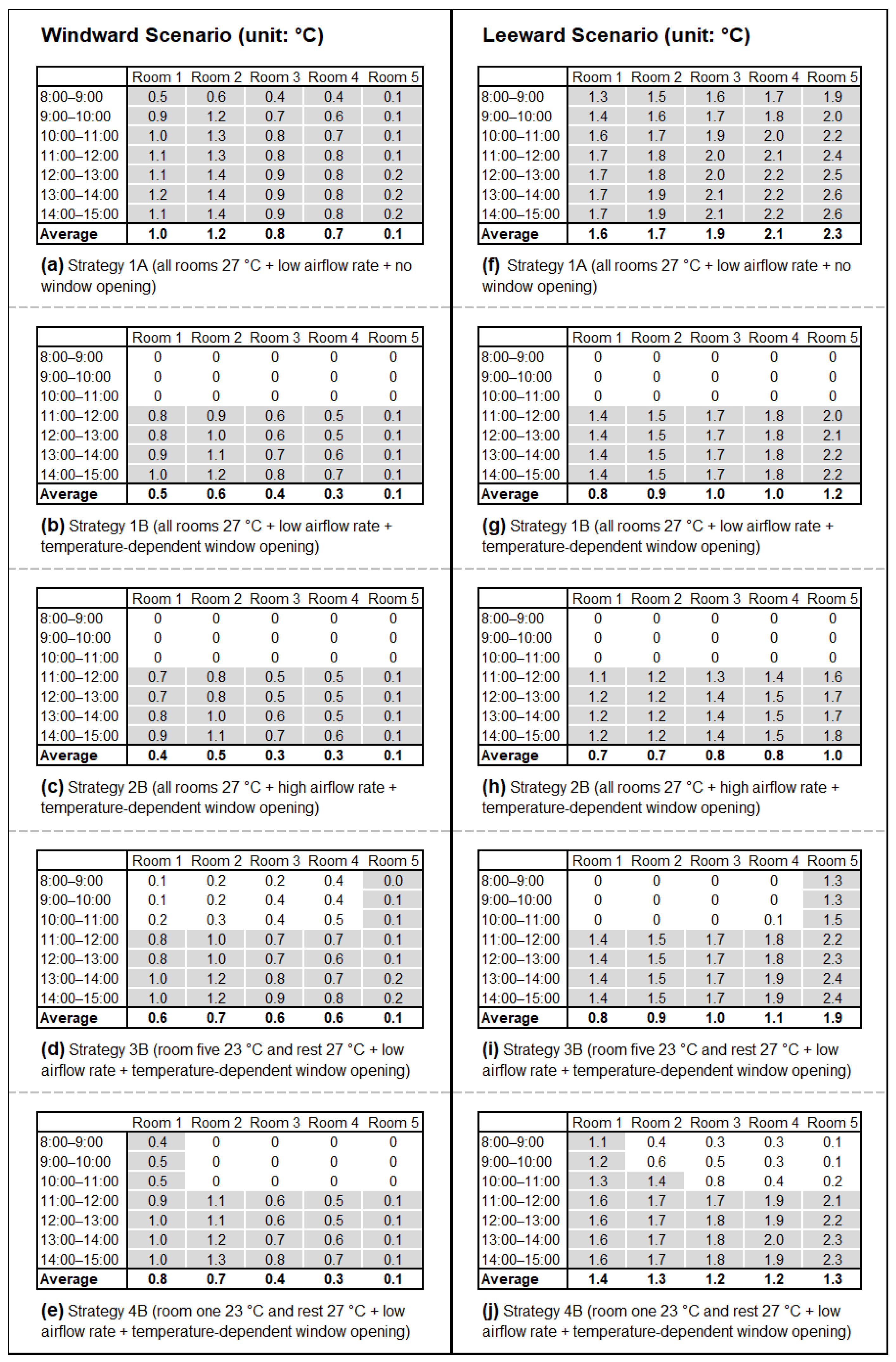

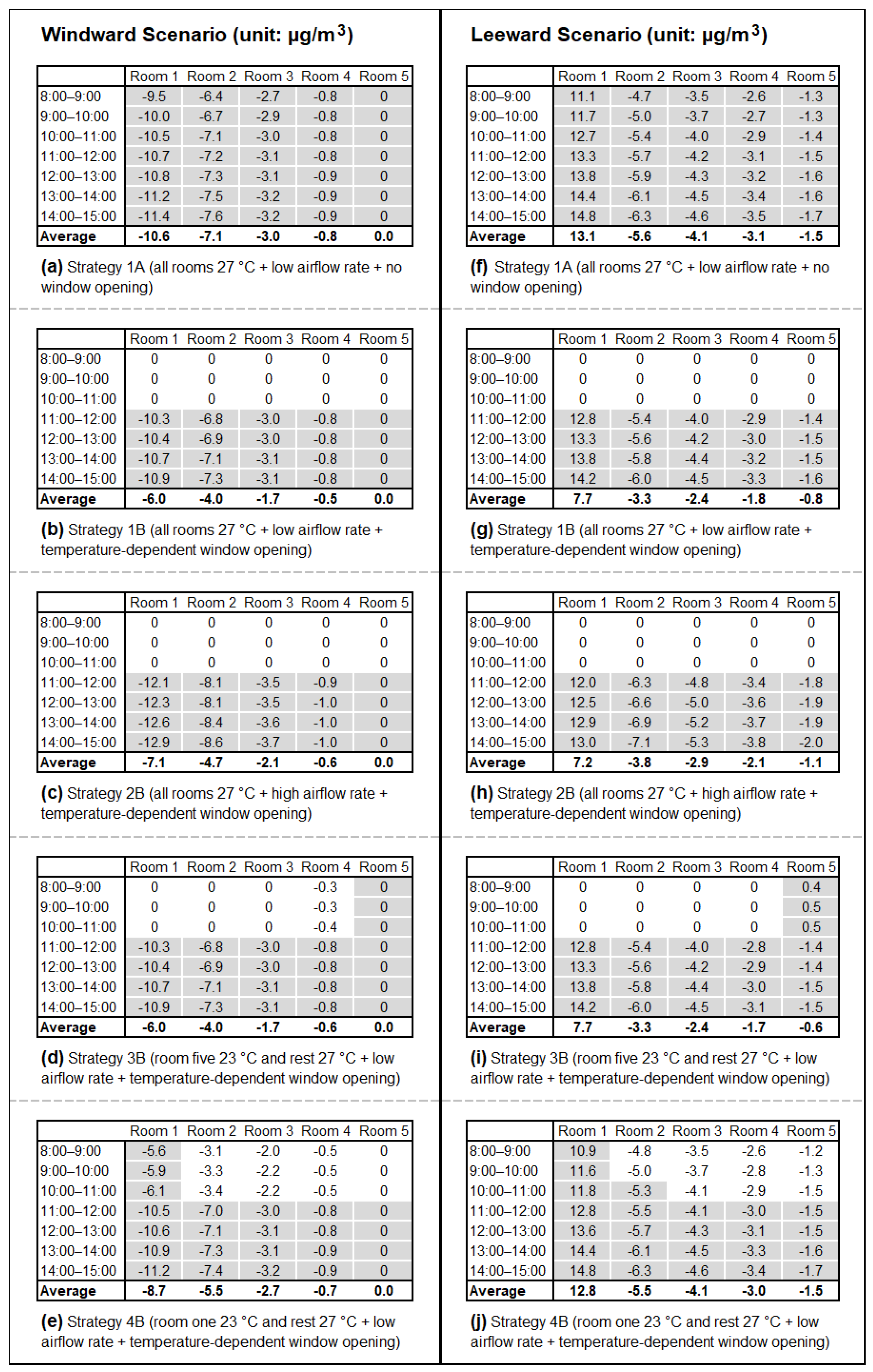


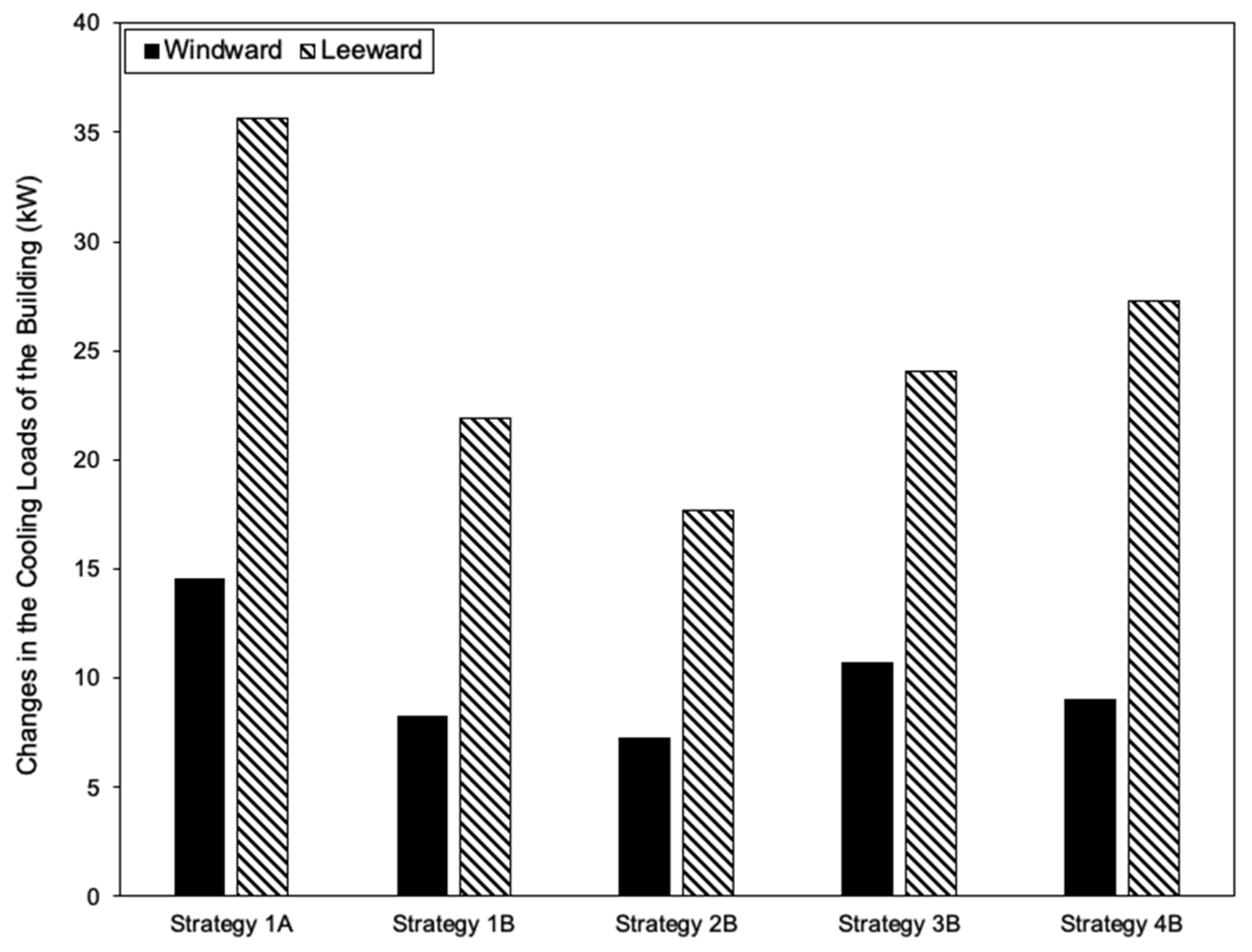
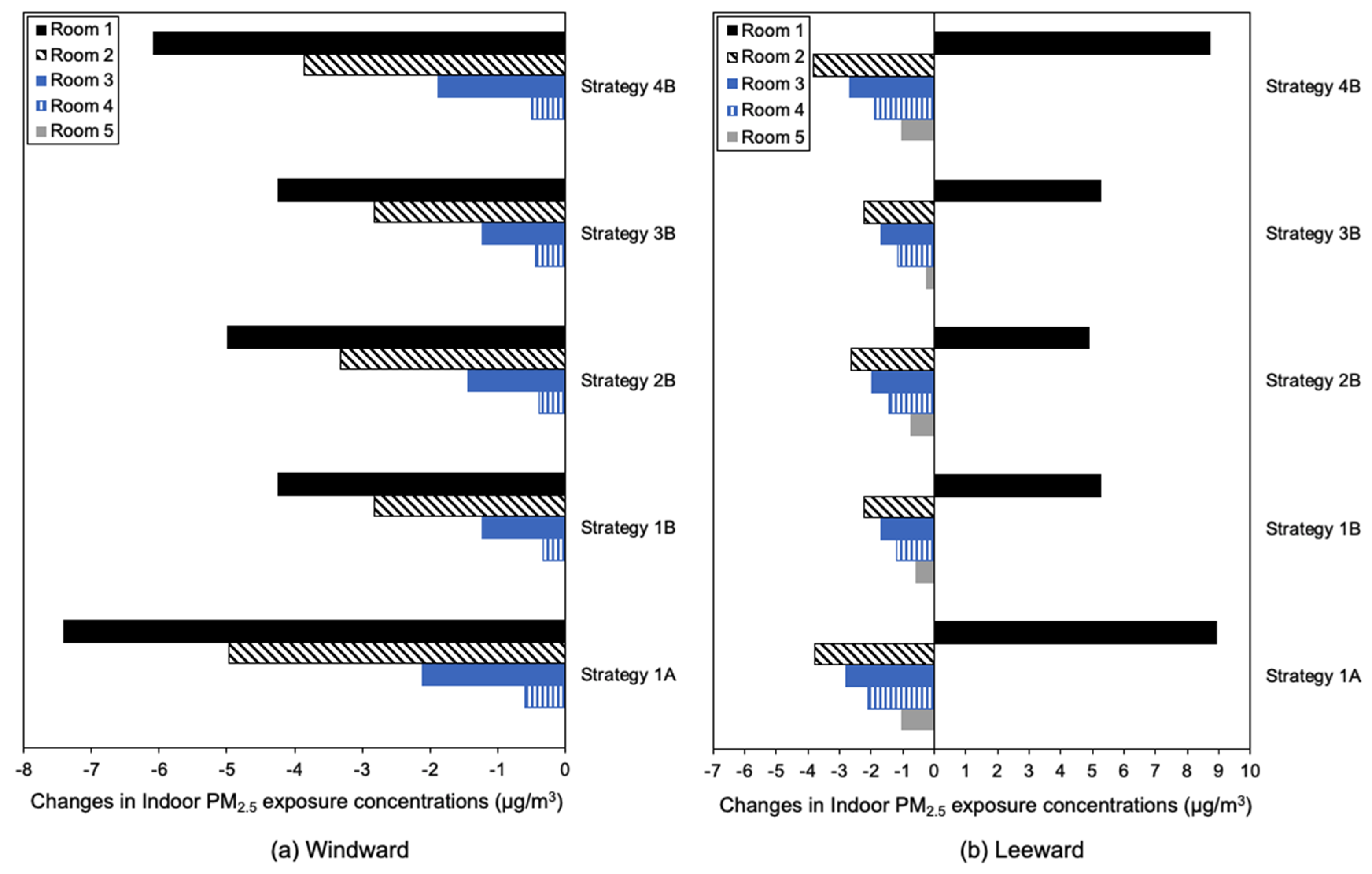
| Type | Materials | U-Value (W/m2K) | Solar Absorptance | Longwave Emission Coefficient | Solar Heat Gain Coefficient (SHGC) |
|---|---|---|---|---|---|
| External walls | Mosaic tiles (5 mm) + Cement (10 mm) + Heavy concrete (100 mm) + Gypsum plaster (10 mm) | 3.1 | Front: 0.4 Back: 0.5 | Front: 0.9 Back: 0.9 | |
| Windows | Tinted glass (6 mm) | 4.6 | 0.5 | ||
| Roof | Concrete tiles (25 mm) + Asphalt (20 mm) + Cement (50 mm) + Polystyrene (50 mm) + Heavy concrete (150 mm) + Gypsum plaster (10 mm) | 0.4 | Front: 0.1 Back: 0.5 | Front: 0.9 Back: 0.9 | |
| Ground floor | Floor tiles (10 mm) + Gypsum plaster (10 mm) + Reinforced concrete (180 mm) | 3.0 | Front: 0.8 Back: 0.5 | Front: 0.9 Back: 0.9 |
| Mixed-Mode Cooling Strategy | Air-Conditioning Pattern | Ventilation Pattern |
|---|---|---|
| Strategy 1A | 1 (all rooms 27 °C + low airflow rate) | A (no window opening) |
| Strategy 1B | 1 (all rooms 27 °C + low airflow rate) | B (temperature-dependent window opening) |
| Strategy 2B | 2 (all rooms 27 °C + high airflow rate) | B (temperature-dependent window opening) |
| Strategy 3B | 3 (room five 23 °C and the rest 27 °C + low airflow rate) | B (temperature-dependent window opening) |
| Strategy 4B | 4 (room one 23 °C and the rest 27 °C + low airflow rate) | B (temperature-dependent window opening) |
| Boundary | Type | Conditions |
|---|---|---|
| Ground | Wall | Non-slip; surface temperatures based on the meteorological data. |
| Building envelope | Wall | Non-slip; exterior surface temperatures outputted by EnergyPlus. |
| Sky and non-inlet/outlet laterals | Wall | Non-slip; adiabatic. |
| Domain inlet | Velocity inlet | Wind speed profile: ; temperature profile: ; turbulence kinetic energy profile: ; and turbulence dissipation rate profile: . |
| Domain outlet | Pressure outlet | Gauge pressure of 0 pa; temperature profile ; turbulence profiles: and . |
| Outlet of the outdoor unit | Velocity inlet | Airflow rate: 65 or 85 m3/min; area of the air outlet: 0.9 m2; and temperature profile of (see Equation (3)). |
Disclaimer/Publisher’s Note: The statements, opinions and data contained in all publications are solely those of the individual author(s) and contributor(s) and not of MDPI and/or the editor(s). MDPI and/or the editor(s) disclaim responsibility for any injury to people or property resulting from any ideas, methods, instructions or products referred to in the content. |
© 2024 by the authors. Licensee MDPI, Basel, Switzerland. This article is an open access article distributed under the terms and conditions of the Creative Commons Attribution (CC BY) license (https://creativecommons.org/licenses/by/4.0/).
Share and Cite
Zhong, X.; Cai, M.; Wang, Z.; Zhang, Z.; Zhang, R. Influences of Heat Rejection from Split A/C Conditioners on Mixed-Mode Buildings: Energy Use and Indoor Air Pollution Exposure Analysis. Buildings 2024, 14, 318. https://doi.org/10.3390/buildings14020318
Zhong X, Cai M, Wang Z, Zhang Z, Zhang R. Influences of Heat Rejection from Split A/C Conditioners on Mixed-Mode Buildings: Energy Use and Indoor Air Pollution Exposure Analysis. Buildings. 2024; 14(2):318. https://doi.org/10.3390/buildings14020318
Chicago/Turabian StyleZhong, Xuyang, Ming Cai, Zhe Wang, Zhiang Zhang, and Ruijun Zhang. 2024. "Influences of Heat Rejection from Split A/C Conditioners on Mixed-Mode Buildings: Energy Use and Indoor Air Pollution Exposure Analysis" Buildings 14, no. 2: 318. https://doi.org/10.3390/buildings14020318





